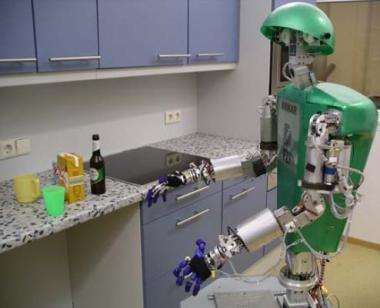November 17, 2010 report
ARMAR-III, the robot that learns via touch (w/ Video)

(PhysOrg.com) -- Researchers in Europe have created a robot that uses its body to learn how to think. It is able to learn how to interact with objects by touching them without needing to rely on a massive database of instructions for every object it might encounter.
The robot is a product of the Europe-wide PACO-PLUS research project and operates on the principle of “embodied cognition,” which relies on two-way communication between the robot’s sensors in its hands and “eyes” and its processor. Embodied cognition enables AMAR to solve problems that were unforeseen by its programmers, so when faced with a new task it investigates ways of moving or looking at things until the processor makes the required connections.
AMAR has learned to recognize common objects to be found in a kitchen, such as cups of various colors, plates, and boxes of cereal, and it responds to commands to interact with these objects by fetching them or placing them in a dishwasher, for example. One example of the tasks AMAR has learned to carry out is setting a table, and it is able to do this even if a cup is placed in its way. The robot worked out that the cup was in the way, was movable, and would be knocked over if left in the way, and so it moved the cup out of the way before continuing with its task.
Project coordinator, Tamim Asfour from the Karlsruhe Institute of Technology in Germany, said the robot’s tasks can be broken down into three components: understanding verbal commands, creating representations of objects and actions, and using these to work out how to carry out the command. Asfour said having the robot learn all three by trial and error would have taken too long, so they provided one of the components and the robot worked out the rest. They reducing the trial and error time by giving AMAR hints via programming, by naming objects, and via a demonstrations from a human.
Asfour said the main scientific achievement of the research was to build a system capable of forming representations of objects that worked at the sensory level and combining that with planning and two-way verbal communication.
The type of thinking demonstrated by AMAR mimics the way humans perceive their environment in terms that depend on their ability to interact with it physically, and it is similar to the way babies and young children learn by exploring the world around them and interacting with objects under guidance.
The four-year PACO-PLUS project was funded by the European Commission’s Cognition Unit with the aim of developing increasing advanced robots able to operate in the real world and communicate with humans.
More information: PACO-PLUS: paco-plus.org/
© 2010 PhysOrg.com





















